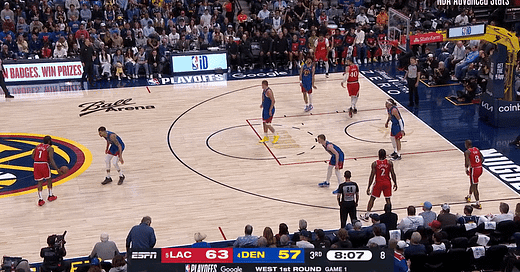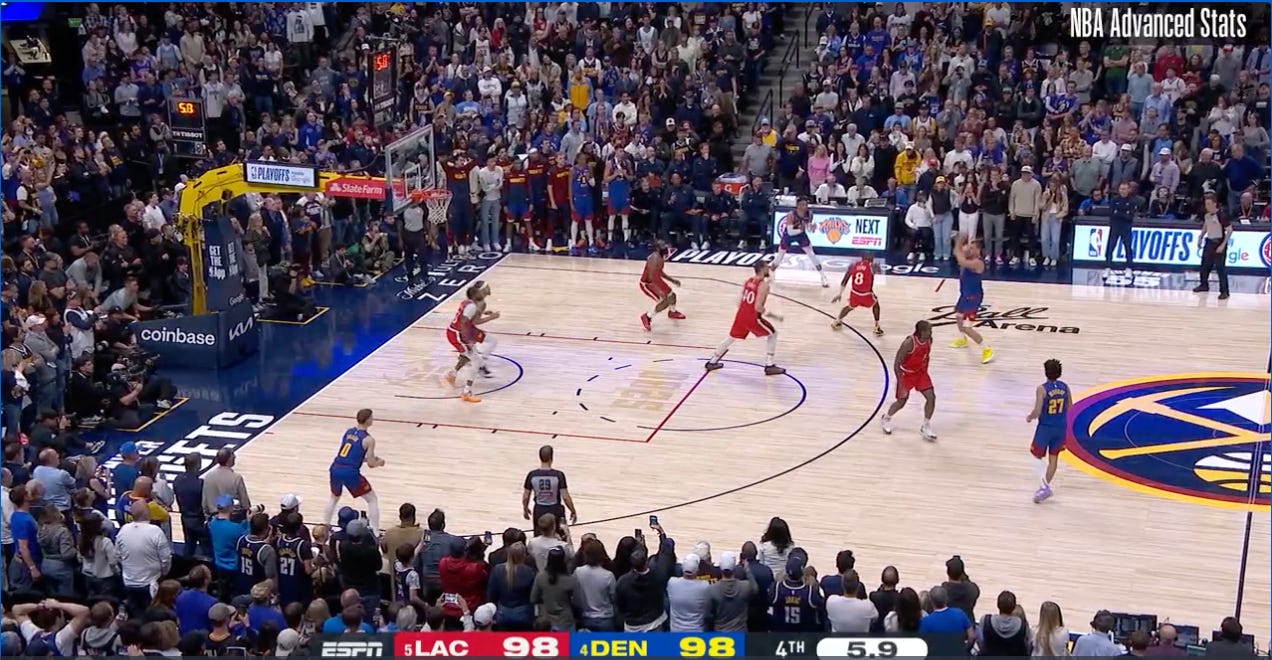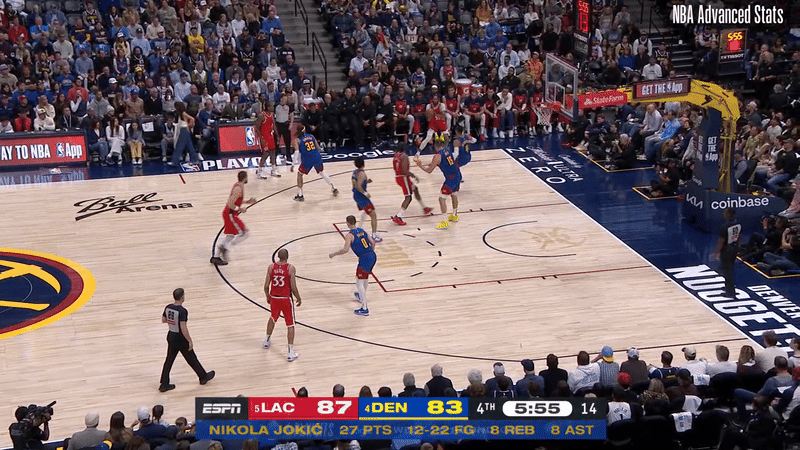One of my favorite semi-regular columns is Anthony Slater’s “Five Observations” recaps after Golden State Warriors games. I hope Slater won’t mind me borrowing the conceit for these playoffs.
The 4-5 matchup between the Denver Nuggets and the Los Angeles Clippers has promised to be the most exciting first round series of the 2025-25 NBA playoffs. And Game 1 lived up to the billing, with a high quality overtime thriller that saw the Nuggets snatch a 1-0 lead.
1. Michael Porter Junior On Ice
Four of the five Nuggets starters played more than 45 minutes. The fifth, Michael Porter Jr. played 27 minutes and was subbed out for the final time with 8:14 left in the fourth quarter. Aside from a couple of defensive possessions with Peyton Watson, Denver’s closing lineup over the last eight minutes of regulation and all of overtime consisted of Nikola Jokic, Jamal Murray, Aaron Gordon, Christian Braun, and Russell Westbrook. That’s the four starters and Westbrook.
In making his playoff picks, Owen Phillips had this to say:
Looking at basketball through the lens of a weak link sport helps explain why teams succeed and fail, especially in the playoffs.
In the postseason, poor defenders are mercilessly hunted on one end while reluctant shooters are blatantly ignored on the other end. It doesn’t matter how good a team’s best player is if their worst player is consistently forcing them to defend or attack 4-on-5. A team’s worst player can all but cancel out the impact of its best player, especially in the playoffs. Instead of boring you with X’s and O’s, mind-numbing numbers, or betting odds on each series, I’m simply going to tell you who I think is the strongest and weakest link in each playoff series. I’m picking the team without the weakest link to advance to the second round.
Phillips identified Westbrook as the weakest link in the series and thus picked the Clippers to advance. While his logic is sound, I wonder if he picked the right team, but the wrong player. The weakest link in this series may be MPJ.
The Nuggets were a -10 in MPJ’s minutes; while single game plus/minus contains more noise than signal, the eye test suggested that the Clippers feasted on MPJ as a defender.
Let’s grant that even better defenders have a hard time guarding James Harden in an isolation situation. This next play is less defensible. Despite being multiple steps behind MPJ, Kawhi Leonard has no trouble accelerating past him and getting an easy transition dunk:
MPJ was subbed out shortly thereafter and rode the pine the rest of the way.
2. Russell Westbrook Cuts Into The Conversation
A big part of why Phillips likely identified Westbrook as the weakest link is Russ’ poor shooting (with MPJ a far superior shooter) and the knock on effect it has on Denver’s spacing. In the regular season, the Nuggets typically had Russ helm second units and generate offense by getting out in transition as often as possible. They followed a similar template at the start of the second quarter, to mixed results. While the Nuggets were able to get out running, it didn’t translate into points and the Clippers built a sizable cushion with Russ running the show and Jokic and Murray on the bench.
Denver and Coach David Adelman made a strategic gamble having Russ close the game. Recognizing that the Clippers were committed to sending double teams at Jokic (and often Murray as well), the Nuggets leveraged Russ’ superior cutting and decision-making behind the double team. Time and time again down the stretch, Russ would cut to the paint as an escape valve for the double-teamed player, and make the right play.
That pass led to a crucial Aaron Gordon bucket in OT. Credit the Nuggets for recognizing that the double would come in the form of Kris Dunn, Russ’ defender, more often than not. It also helps when the player being doubled is Nikola Jokic, a GOAT passer out of double teams.
On commentary, Bob Myers and Ryan Ruocco (Nets fans know that Ruocco is the best) attributed Russ’ presence in the clutch to his hustle and commitment to getting offensive boards. I think his ability to bust open the Clippers’ defensive scheme in this game may have played a greater part.
3. Denver’s Icky Spacing
While the Nuggets pulled out the win, it was grimy down the stretch. The spacing with Westbrook on the floor was sub-optimal, never more so than on the last play of regulation where the Nuggets were unable to get a shot off. Watch how far James Harden is sagging off of Westbrook in the picture below, giving him ample opportunity to recover back onto Aaron Gordon should the tagger (Derrick Jones Jr.) need to scramble back out to Christian Braun on the perimeter.
The Nuggets may have missed a trick here, placing Westbrook by himself in the weak side corner (although it looks like Braun is the one in the weak side corner, the pass to Jokic came from Murray at the bottom of the screen.) One huge three towards the end of regulation notwithstanding, Russ is not a threat out on the perimeter, which allowed Kris Dunn to bring an aggressive double over to Jokic.
Much better is what Denver managed on Braun’s three in overtime. Russ stands in the dunker spot, where Dunn is forced to guard him, while Aaron Gordon cuts towards the rim with Harden matched up on him. Jokic can easily find Gordon below the basket here with a mismatch, forcing Powell to shade in behind Harden and giving Dunn the long closeout on Braun. Barbecue sauce.
If the Russ + starters lineup is to see extended minutes this series, Denver may need to mix in some off ball Russ/Braun action. How about Russ cutting over to the other side? Russ setting a flex screen for Braun? Braun himself is a canny cutter, scoring 1.43 points per possession in the regular season per NBA tracking data. There are counters to the counters available.
4. LA’s icky offense
At one point, with the Clippers offense humming, Bob Myers noted that LA would be happy to let their two isolation studs cook solo. The Clippers may have been hoisted on their own petard though. On a crucial possession, Kawhi Leonard dribbled down the clock and launched a three that missed. On one of the final plays in regulation, sizing up a mismatch with Jamal Murray, he had the ball knocked out of bounds off his own hip.
This may be my own bias towards motion concepts and the Steve Kerr Warriors showing, but the best way to exploit a mismatch isn’t always to just dribble the air out of the ball and go iso Joe. Against one of the league’s worse defenses, the Clippers, barely managed 108 points per 100 possessions in Game 1.
Part of the answer may be channeling more of the offense through James Harden when he and Kawhi share the floor together. Harden is a savvier offensive decision maker when it comes down to it. More of this please:
Bob Myers kept calling for more Harden-Zubac pick and roll. That’s another option that I was puzzled to see the Clippers mothball down the stretch. Pick and rolls with Zubac as the roll man yield 1.25 points per possession, one of the best marks in the league (that number is 1.29 for Jokic, for what it’s worth.) Maybe Coach Lue should be hammering the Harden-Zubac two man game more.
5. Pace and Rebounding
With two minutes to go in regulation and a mere one point lead, Denver resorted to prevent offense. Multiple possessions consisted of Jamal Murray holding the ball near mid-court, before the Nuggets sauntered into an offensive set with seconds left on the shot clock, followed by a contested pull up three. Denver was one of the faster teams in the league in the regular season, a tick above even the run-and-gun Indiana Pacers. That was not the case in Game 1. I think Denver will need to get into its crunch time offense quicker going forward. Go watch the final possession of regulation again.
That Denver didn’t pay a price for their lollygagging is down to a number of critical offensive rebounds. For every aimless possession ending in a contested miss, Denver managed to snatch multiple offensive boards. The Nuggets had a top five offensive rebounding rate in the regular season per Cleaning the Glass.
The team with the best defensive rebounding rate? That would be the Los Angeles Clippers. Maybe this is a case of irresistible force meeting immovable object and the Nuggets’ force triumphing. I wouldn’t be so sure though. Over 97 possessions, the Russ+starters lineup had a mere 24% offensive rebounding rate, in the 12th percentile for lineups per Cleaning the Glass and 20% below Denver’s average. I’m not sure the Nuggets should count on the offensive rebounding rate to persist in the long term.
Closing Thoughts
Big picture, the adjustment for LA may be as simple as “play better” on the margins; with even a couple of offensive possessions shaded away from the iso morass and one or two of the offensive boards swinging their way, the result of Game 1 may have been different. Another subplot I will be watching: How much LA persists with Nicolas Batum at center when Nikola Jokic is on the court. And lurking in the background is the specter of Playoff Jamal Murray (7/20 from the field in Game 1.)









